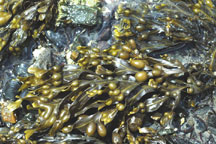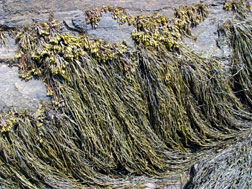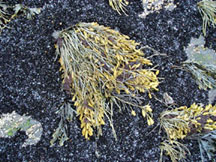 |
 |
|||||||||||||||
|
There are four species of brown seaweed commonly found in the lower intertidal. The two species that are most obvious are Fucus vesiculosus, above left and Ascophylum nodosum, above right. These algae range in color from yellowish brown to olive to dark brown. Fucus vesiculosus or bladder wrack, is easily recognized by its shorter, bushier appearance. Its vesicles are paired and its midrib is very distinct on flat, branched blades. If this species lives in an area where there is especially heavy wave action, it may not have vesicles. What is the benefit of not growing vesicles? Ascophyllum nodosum also known as knotted wrack is recognized by its longer, hair-like appearance. Knotted wrack can reach up to 10 feet in length. The vesicles are in line along the blade and produced annually, making this algae easy to age. |
||||||||||||||||
Try this... |
||||||||||||||||
|
||||||||||||||||




